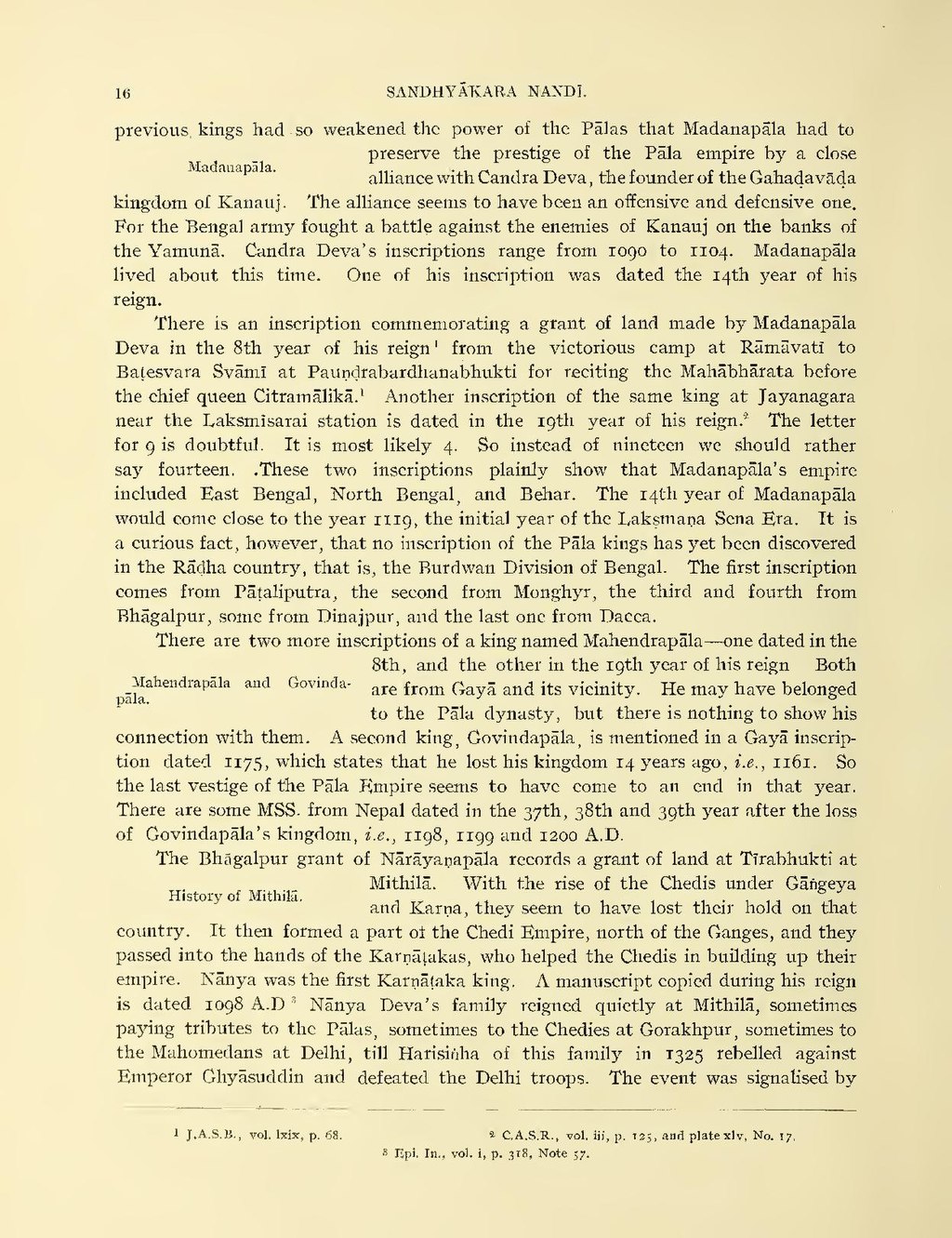SANDHYAKARA NANDI. previous kings had so weakened the power of the Palas that Madanapala had to Madanapala. preserve the prestige of the Pala empire by a close alliance with Candra Deva, the founder of the Gahadavāda kingdom of Kanauj. The alliance seems to have been an offensive and defensive one. For the Bengal army fought a battle against the enemies of Kanauj on the banks of the Yamuna. Candra Deva's inscriptions range from 1090 to 1104. Madanapala lived about this time. One of his inscription was dated the 14th year of his reign. 16 There is an inscription commemorating a grant of land made by Madanapāla Deva in the 8th year of his reign from the victorious camp at Rāmavati to Batesvara Svāmī at Pauṇḍrabardhanabhukti for reciting the Mahabharata before the chief queen Citramālikā. Another inscription of the same king at Jayanagara near the Laksmisarai station is dated in the 19th year of his reign. The letter for 9 is doubtful. It is most likely 4. So instead of nineteen we should rather say fourteen. These two inscriptions plainly show that Madanapala's empire included East Bengal, North Bengal, and Behar. The 14th year of Madanapala would come close to the year 1119, the initial year of the Laksmana Sena Era. It is a curious fact, however, that no inscription of the Pala kings has yet been discovered in the Radha country, that is, the Burdwan Division of Bengal. The first inscription comes from Paṭaliputra, the second from Monghyr, the third and fourth from Bhagalpur, some from Dinajpur, and the last one from Dacca. Mahendrapala and Govinda- There are two more inscriptions of a king named Mahendrapala-one dated in the 8th, and the other in the 19th year of his reign Both are from Gaya and its vicinity. He may have belonged to the Pala dynasty, but there is nothing to show his connection with them. A second king, Govindapāla, is mentioned in a Gayā inscrip- tion dated 1175, which states that he lost his kingdom 14 years ago, i.e., 1161. So the last vestige of the Pala Empire seems to have come to an end in that year. There are some MSS. from Nepal dated in the 37th, 38th and 39th year after the loss of Govindapala's kingdom, i.e., 1198, 1199 and 1200 A.D. The Bhagalpur grant of Nārāyaṇapāla records a grant of land at Tirabhukti at With the rise of the Chedis under Gangeya History of Mithila. Mithila. and Karna, they seem to have lost their hold on that country. It then formed a part of the Chedi Empire, north of the Ganges, and they passed into the hands of the Karnatakas, who helped the Chedis in building up their empire. Nanya was the first Karnataka king. A manuscript copied during his reign is dated 1098 A.D Nãnya Deva's family reigned quietly at Mithila, sometimes paying tributes to the Palas, sometimes to the Chedies at Gorakhpur, sometimes to the Mahomedans at Delhi, till Harisinha of this family in 1325 rebelled against Emperor Ghyāsuddin and defeated the Delhi troops. The event was signalised by pāla. 1 J.A.S.B., vol. lxix, p. 68. 2 C.A.S.R., vol. iii, p. 125, and plate xlv, No. 17. 3 Epi. In., vol. i, p. 318, Note 57.

